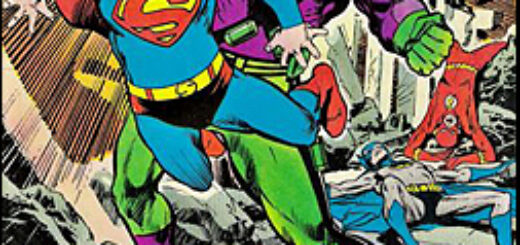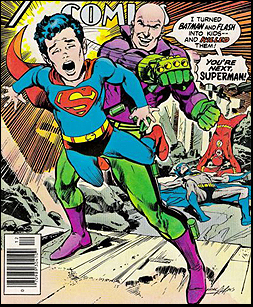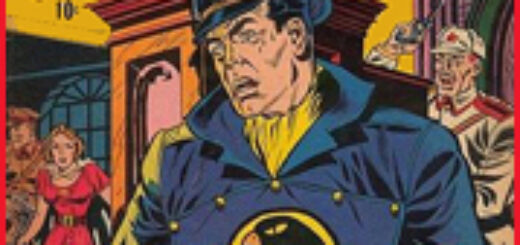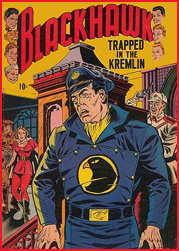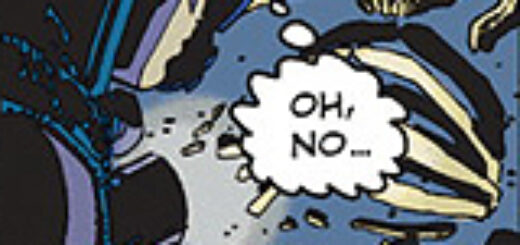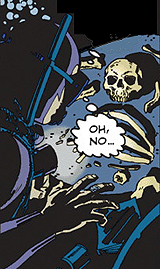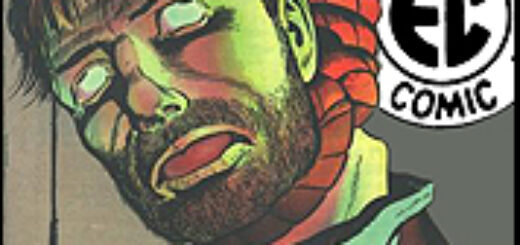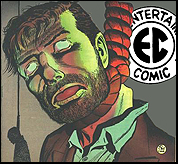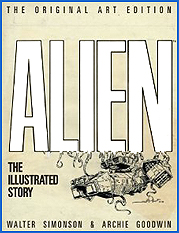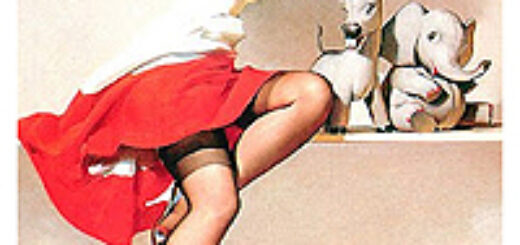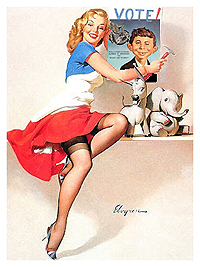Mike Gold’s Top 9 of 2012
 It’s the end of the year, so it’s time for still another mindless list of favorites – maintaining a cloying, egotistical annual tradition throughout the media. Once again, here are my self-imposed rules: I’m only listing series that either were ongoing or ran more than six issues, I’m not listing graphic novels or reprints as both compete under different criteria, I’m not covering Internet-only projects as I’d be yanking the rug out from under my pal Glenn Hauman, and I’m listing only nine because tied for tenth place would be about two dozen other titles and I’ve only got so much bandwidth. Besides, “nine” is snarky and when it comes to reality, I am one snarky sumbytch – but only for a living. On Earth-Prime, I’m really a sweet, kind, understanding guy.
It’s the end of the year, so it’s time for still another mindless list of favorites – maintaining a cloying, egotistical annual tradition throughout the media. Once again, here are my self-imposed rules: I’m only listing series that either were ongoing or ran more than six issues, I’m not listing graphic novels or reprints as both compete under different criteria, I’m not covering Internet-only projects as I’d be yanking the rug out from under my pal Glenn Hauman, and I’m listing only nine because tied for tenth place would be about two dozen other titles and I’ve only got so much bandwidth. Besides, “nine” is snarky and when it comes to reality, I am one snarky sumbytch – but only for a living. On Earth-Prime, I’m really a sweet, kind, understanding guy.
Having said all that, let’s open that hermetically sealed jar on the porch of Funk and Wagnalls and start.
1. Manhattan Projects. If I had to write a Top 9 of the Third Millennium list, I’d be hard pressed not to include this title. It’s compelling, it’s different, it’s unpredictable and it’s brilliantly executed by writer Jonathan Hickman and artist Nick Pitarra. It turns out the scientists and the military leaders behind the creation and the execution of the Atomic Bomb had a lot more in mind than just nuking Japan… a lot more. And their plans run decades longer than World War II. Based largely upon real-life individuals who are too dead to litigate, each person seems to have his own motivations, his own ideas for execution, and his own long-range plan for how to develop the future. Yet the story never gets bogged down in political posturing or self-amusing cuteness – the latter being a real temptation for many creators. Each issue gives us the impression there’s more than meets the eye; each successive issue proves there most certainly was. If the History Channel spun off a Paranoia Network, Manhattan Projects would be its raison d’être.
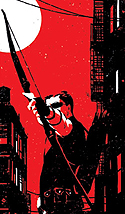 2. Hawkeye. If you’ll pardon the pun, Hawkeye has never been more than a second-string character. An interesting guy with an involving backstory and enough sexual relationships to almost fill a Howard Chaykin mini-series, this series tells us what Clint Barton does when he’s not being an Avenger or a S.H.I.E.L.D. camp follower. It turns out Clint leads a normal-looking life that gets interfered with by people who think Avengers should be Avengers 24/7. He’s also got a thing going with the Young Avenger who was briefly Hawkeye. Matt Fraction and David Aja bring forth perhaps the most human interpretation of a Marvel character in a long, long while. Hawkeye might be second-string, but Clint Barton most certainly is not.
2. Hawkeye. If you’ll pardon the pun, Hawkeye has never been more than a second-string character. An interesting guy with an involving backstory and enough sexual relationships to almost fill a Howard Chaykin mini-series, this series tells us what Clint Barton does when he’s not being an Avenger or a S.H.I.E.L.D. camp follower. It turns out Clint leads a normal-looking life that gets interfered with by people who think Avengers should be Avengers 24/7. He’s also got a thing going with the Young Avenger who was briefly Hawkeye. Matt Fraction and David Aja bring forth perhaps the most human interpretation of a Marvel character in a long, long while. Hawkeye might be second-string, but Clint Barton most certainly is not.
3. Captain Marvel. Another second-string character. Despite some absolutely first-rate stories (I’m quite partial to Jim Starlin’s stuff, as well as anything Gene Colan or Gil Kane ever put pencil to paper), the guy/doll never came close to the heritage of its namesake. This may have changed. A true role model for younger female readers and a very military character who uniquely humanizes the armed forces, Carol Danvers finally soars under writer Kelly Sue DeConnick and artist Dexter Soy – both as a superhero and as a human being. DeConnick doesn’t qualify as “new” talent, but this certainly is a breakthrough series that establishes her as a truly major player… as it does Marvel’s Captain Marvel.
4. Creator-Owned Heroes. Anthology comics are a drag upon the direct sales racket. They almost never succeed. I don’t know why; there’s usually as much story in each individual chapter as there is in a standard full-length comic. I admire anybody who choses to give it a whirl (hi, there, honorary mention Mike Richardson and company for Dark Horse Presents!), and I really liked Creator-Owned Comics. Yep, liked. It’s gone with next month’s eighth issue. But this one was a lot more than an anthology comic: it had feature articles, how-to pieces, and swell interviews. The work of Jimmy Palmiotti, Justin Gray, Steve Niles, Steve Bunche and a cast of dozens (including swell folks like Phil Noto and Darwin Cooke), there wasn’t a clinker in the bunch. I wouldn’t mind seeing follow-ups on any of the series featured in this title, although I must give a particular nod to Jimmy and Justin’s Killswitch, a take on modern contract killers, and on Steve’s work in general. This is no light praise: I’m not a big fan of horror stories because most of them have been done before and redone a thousand times after that. Niles is quite the exception.
5. Batman Beyond Unlimited. Okay, this is a printed collection of three weekly online titles: Batman Beyond, Justice League Beyond, and Superman Beyond. But it comes out every month in a sweet monthly double-length printed comic, so it meets my capricious criteria. Based upon the animated DC Universe (as in, the weekly series Batman Beyond and Justice League, and to a lesser extent others), these stories are solid, fun, and relatively free of the angst that has overwhelmed the so-called real DCU stories. Yeah, kids can enjoy them. So can the rest of the established comics audience. Pull the stick out of your ass; there’s more to superhero comics than OCD heroes and death and predictable resurrection. These folks have just about the best take on Jack Kirby’s Fourth World characters than anybody since Jack Kirby. That’s because Jack remembered comics are supposed to be entertaining. Honorable mention: Ame-Comi Girls. It’s based on a stupid (but successful) merchandising idea but it’s just as much fun as anything being published today.
 6. Batgirl. O.K. The real story here is that DC Comics mindlessly offed writer Gail Simone from this series only to restore her within a week or so after serious (and occasionally, ah, overly dramatic) protest from both the readership and the creative community. But there was good reason: Gail took a character who was in an impossible situation and, against all tradition, put her back in the costume without resorting to ret-con or reboot, which have been the handmaidens of the New 52. She brought Barbara Gordon back to action with all the doubts, insecurities and vulnerabilities one would expect a person in her position to have, and she does so in a compelling way exercising all of her very considerable talent. This title thrives despite being engulfed in two back-to-back mega-non-events that overwhelmed and undermined all of the Batman titles.
6. Batgirl. O.K. The real story here is that DC Comics mindlessly offed writer Gail Simone from this series only to restore her within a week or so after serious (and occasionally, ah, overly dramatic) protest from both the readership and the creative community. But there was good reason: Gail took a character who was in an impossible situation and, against all tradition, put her back in the costume without resorting to ret-con or reboot, which have been the handmaidens of the New 52. She brought Barbara Gordon back to action with all the doubts, insecurities and vulnerabilities one would expect a person in her position to have, and she does so in a compelling way exercising all of her very considerable talent. This title thrives despite being engulfed in two back-to-back mega-non-events that overwhelmed and undermined all of the Batman titles.
7. Orchid. I praised this one last year; it comes to an end with issue 12 next month. That’s because writer/creator/musician/activist Nightwatchman Tom Morello has a day job and the young Wobblie still has a lot of rabble to rouse. Orchid is a true revolutionary comic book wherein a growing gaggle of the downtrodden stand up for themselves against all odds and unite to defeat the omnipresent oppressor. Tom manages to do this without resorting to obvious parallels to real-life oppressors, although the environment he creates will be recognizable to anybody who thinks there just might be something wrong with Fox “News.” But this is a comic book site and not the place for (most of) my social/political rants (cough cough). Orchid succeeds and thrives as a story with identifiable, compelling characters and situations and a story that kicks ass with the energy and verve one would expect from a rock’n’roller like Morello.
8. Revival. A somewhat apocalyptic tale about people who come back from the dead in the fairly isolated city of Wausau Wisconsin (I’ve been there several times; it is a city and it is indeed fairly isolated). But they aren’t zombies. Most are quite affable. It’s the rest of the population that’s got a problem. The latest output from Tim Seeley and my landsman Mike Norton, two enormously gifted talents. Somewhere above I noted how Steve Niles is able to raise well above the predictable crap and that is equally true here: the story and formula is typical, but the execution is compelling. That I’ve been a big fan of Norton’s is no surprise to my friends in Chicago.
9. Nowhere Men. I’ve got to thank my ComicMix brother Marc Alan Fishman for this one. Admittedly, it’s only two issues old and it has its flaws – long prose insertions almost always bring the pace of visual storytelling to a grinding halt – but the concept and execution of this series far exceeds this drawback. Written by Eric Stephenson and drawn by Nate Bellegarde and Jordie Bellaire, the catch phrase here is “Science Is The New Rock ‘N’ Roll.” Four guys start up a science-for-the-people company and that’s cool, but twenty years later some have taken it too seriously, others not seriously enough, and things got a little out of hand. Sadly, I’m not certain who understands that, other than the reader and one of the major characters. Science is the new rock’n’roll, and exploring that as a cultural phenomenon makes for a great story – and a solid companion to Manhattan Projects.
Non-Self-Publisher of the Year: For some reason, I’m surprised to say it’s Image Comics. They’ve been publishing many of the most innovative titles around – four of the above nine – all creator-owned, without going after licensed properties like a crack-whore at a kneepad sale.
No offense meant to either publishers or crack-whores; I said I’m really a sweet, kind, understanding guy.
THURSDAY: Dennis O’Neil


